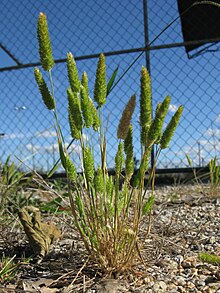Real tufted grass
| Real tufted grass | ||||||||||||
|---|---|---|---|---|---|---|---|---|---|---|---|---|

Real tufted grass ( Rostraria cristata ) |
||||||||||||
| Systematics | ||||||||||||
|
||||||||||||
| Scientific name | ||||||||||||
| Rostraria cristata | ||||||||||||
| (L.) Tzvelev |
Real tuft grass ( Rostraria cristata ) is a species of the genus tuft grass ( Rostraria ) and thus the family of sweet grasses (Poaceae).
description
The real tufted grass is an annual grass that grows in dense clusters or with individual stalks. The stalks reach heights of 6–40– (69) centimeters, are erect or kneeling-ascending and mostly branched at the base. The stalk is thin, grooved, glabrous and has 3–5 knots. The leaf sheaths are densely covered with fine hairs about one millimeter long. The ligule is a collar-shaped edge that is only 0.5–1 millimeters long. The leaf blades are 4–26 centimeters long and 1–4–8 millimeters wide, spread out flat and covered with long, fine hairs. The flower panicle is 1–10 centimeters long and 5–29 millimeters wide, dense and cylindrical, seldom loose and strongly lobed. The pedicels are only 0.2-0.5 millimeters long. The spikelets are two-flowered to six-flowered and (without the awns) 3–6 millimeters long. The glumes are unequal, the lemma is five-veined, membranous and slightly awned under the tip. The palea are two-veined, 2.0-2.6 millimeters long. The anthers are 0.2-0.4 millimeters long.
The flowering period is April to May, sometimes July to September.
The chromosome number is 2n = 26 or 28.
distribution
The tufted grass occurs from the Mediterranean area to the Sahara and India, from the Caucasus to Central Asia and the western Himalayas and in Macaronesia. It occurs on roadsides, ruderal sites, on rubble sites on very dry, base-rich, moderately nutrient-rich, slightly humic, sandy soils. It is an indicator of thinness and thrives in Sisymbrion societies. In Germany the species occurs only inconsistently introduced.
Taxonomy
Rostraria cristata was first described by Carl von Linné as Festuca cristata in Sp. Pl .: 76 (1753). Only in 1971 did Tzvelev Sist in Novosti. Vyssh. Rest. 7: 47 (1970 publ. 1971) placed them under the name Rostraria cristata (L.) Tzvelev in the genus Rostraria . Synonyms for Rostraria cristata (L.) Tzvelev are, for example: Lophochloa cristata (L.) Hyl. , Trisetum cristatum (L.) Potztal , Trisetaria cristata (L.) Kerguélen , Bromus poiformis Forssk. , Bromus trivialis Savi , Koeleria phleoides Pers. , Koeleria dactyloides Spreng. , Festuca glaucescens Roth , Koeleria phleoides Pers. and Koeleria campestris Phil.
literature
- Hans Joachim Conert: Rostraria . In: Gustav Hegi : Illustrated flora of Central Europe . 3rd ed., Volume I, Part 3, pages 277-281. Verlag Paul Parey, Berlin, Hamburg, 1987. ISBN 3-489-52320-2 (description, distribution)
Individual evidence
- ↑ a b Rafaël Govaerts (Ed.): Rostraria cristata. In: World Checklist of Selected Plant Families (WCSP) - The Board of Trustees of the Royal Botanic Gardens, Kew . Retrieved June 22, 2020.

